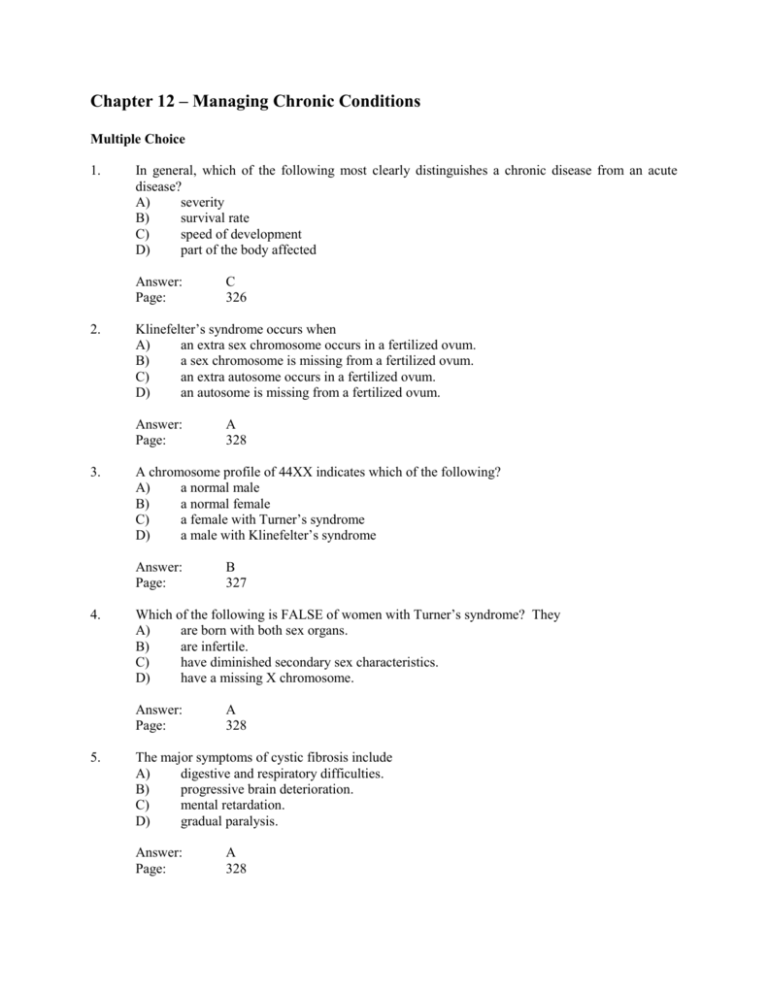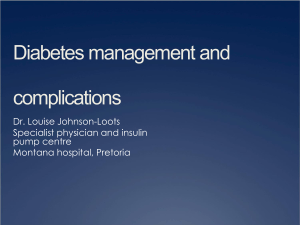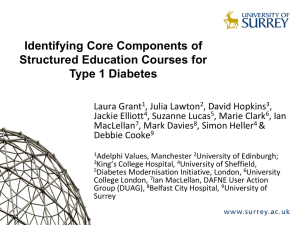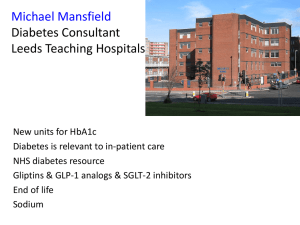Chap12, Ch12
advertisement

Chapter 12 – Managing Chronic Conditions Multiple Choice 1. In general, which of the following most clearly distinguishes a chronic disease from an acute disease? A) severity B) survival rate C) speed of development D) part of the body affected Answer: Page: 2. Klinefelter’s syndrome occurs when A) an extra sex chromosome occurs in a fertilized ovum. B) a sex chromosome is missing from a fertilized ovum. C) an extra autosome occurs in a fertilized ovum. D) an autosome is missing from a fertilized ovum. Answer: Page: 3. B 327 Which of the following is FALSE of women with Turner’s syndrome? They A) are born with both sex organs. B) are infertile. C) have diminished secondary sex characteristics. D) have a missing X chromosome. Answer: Page: 5. A 328 A chromosome profile of 44XX indicates which of the following? A) a normal male B) a normal female C) a female with Turner’s syndrome D) a male with Klinefelter’s syndrome Answer: Page: 4. C 326 A 328 The major symptoms of cystic fibrosis include A) digestive and respiratory difficulties. B) progressive brain deterioration. C) mental retardation. D) gradual paralysis. Answer: Page: A 328 6. The pancreas and other structures that secrete substances through ducts are called ____ glands. A) endocrine B) exocrine C) lymph D) cystic Answer: Page: 7. Which of the following is NOT a symptom related to cystic fibrosis? A) respiratory system problems B) enlarged fingertips C) the ability to control mucus production D) digestive system problems Answer: Page: 8. A 328 Many inherited disorders are recessive, which means that the genes that cause them are A) rare. B) carried by both parents. C) not revealed in every generation. D) only found in about one out of four family members. Answer: Page: 11. D 328 A new technique that attempts to cure a chronic disease by introducing healthy genes into a person with a genetic disorder is called A) gene replacement therapy. B) genetic palliative therapy. C) genetic alleviation. D) gene splicing. Answer: Page: 10. B 328 Your cousin has a chronic disorder that requires daily respiratory therapy, drugs, and a special diet. He most likely has A) muscular dystrophy. B) Tay-Sachs disease. C) Down syndrome. D) cystic fibrosis. Answer: Page: 9. B 328 B 328 Sickle-cell disease is most prominent in A) Hispanic Americans. B) African Americans. C) Eastern European Jews. D) Caucasians. Answer: Page: 12. People with sickle-cell disease may live to reach _____ years of age. A) 30 B) 85 C) 50 D) 75 Answer: Page: 13. D 329 In sickle-cell disease, the characteristic sickle-shaped cells are A) genetic flaws in certain types of white blood cells. B) congenital abnormalities in blood vessel walls. C) elongated and unable to pass through the body’s minute capillaries. D) cancerous cells in the bone marrow. Answer: Page: 16. B 329 Which of the following is NOT a serious medical problem associated with sickle-cell disease? A) anemia B) congestive heart failure C) gall bladder infections D) recurrent pneumonia Answer: Page: 15. C 329 You are a carrier of the sickle-cell gene. How will this affect your health? A) It will shorten your life expectancy. B) It will have almost no effect on your health. C) You will be susceptible to frequent infections. D) You will have one chance in four of developing sickle-cell disease. Answer: Page: 14. B 328 C 329 A form of dementia caused by the gradual loss of brain function is referred to as A) Parkinson’s disease. B) Alzheimer’s disease. C) Crohn’s disease. D) Turner’s syndrome Answer: Page: B 345 17. Anterior vertebral stapling is a procedure used in those cases of scoliosis in which A) the curvature is 45 degrees or less. B) the curvature is 45 degrees or more. C) the curvature is 30 degrees or less. D) This procedure is not currently used in the treatment of scoliosis. Answer: Page: 18. In human embryos, most development and differentiation of tissues and organs is complete by _______________ after fertilization. A) eight days B) three weeks C) six weeks D) three months Answer: Page: 19. D 330 What are the most significant risks of refusing to get medical treatment for a cleft palate? A) The risks are mainly cosmetic. B) Speech and eating difficulties are likely. C) The tissue around the brain is at high risk of infection. D) The condition can worsen and become life-threatening. Answer: Page: 22. B 330 Which of the following is the BEST example of a congenital abnormality? A) a spontaneous abortion B) an inherited blood disorder C) cystic fibrosis D) a cleft palate Answer: Page: 21. D 330 Which of the following is FALSE regarding congenital abnormalities? A) No single factor is responsible for congenital abnormalities. B) They are solely caused by environmental factors. C) Inappropriate changes in tissue during the embryonic development cause congenital abnormalities. D) They are generally formed early in pregnancy. Answer: Page: 20. C 332 B 330 Your doctor reports that your newborn infant has a condition called patent foramen ovale. What is most likely to happen now? A) The child will probably die within hours. B) Chances are good that no special treatment will be needed. C) D) Corrective surgery will be performed before the child leaves the hospital. The child will probably need supplemental oxygen for the first three months of life. Answer: Page: 23. A recent scuba diving incident brought to your attention that you had an undiagnosed patent foramen ovale. Most interesting to you was the fact that A) you should never have been able to compete in school sports. B) it is difficult for doctors to miss this diagnosis in newborns. C) you should have died in infancy. D) this condition could increase the risk of decompression illness. Answer: Page: 24. A 332 Your adolescent son has been diagnosed with scoliosis. The degree of curvature is 34 degrees. What treatment will most likely be recommended? A) a brace B) exercise therapy C) surgical correction D) no immediate treatment, but monitoring at six-month intervals Answer: Page: 27. C 331 Children with scoliosis should A) be screened every 6-9 months until growth of the spine slows and then stops. B) have corrective surgery as soon as possible. C) not be concerned as most children grow out of it. D) wear a brace even when the there is only a minor curvature (less than 10 degrees). Answer: Page: 26. D 331 Fifteen-year-old Rodney has a pronounced twist in his backbone that seems to get worse as he grows. He probably has A) spina bifida. B) thoracica. C) scoliosis. D) talipes. Answer: Page: 25. B 331 A 332 Both major types of diabetes occur because of A) too much sugar in the blood. B) too much insulin in the blood. C) the body’s insensitivity to insulin. D) the body’s inability to regulate blood sugar. Answer: Pages: 28. Hyperglycemia occurs when A) the blood contains an abnormally low amount of glucose. B) excessive amounts of glucose accumulate in the blood. C) abnormal quantities of glucose pour into cells. D) the body cannot produce enough insulin. Answer: Page: 29. B 334, 336 The cause of type 1 diabetes is the destruction of insulin-producing sites by A) a viral infection. B) mutated pancreatic cells. C) one’s own immune system. D) excessive levels of blood glucose. Answer: Page: 33. A 333 Type 1 (insulin-dependent) diabetes occurs when the A) body becomes insensitive to insulin. B) body loses its ability to produce insulin. C) pancreas starts to release an ineffective form of insulin. D) body develops a hypersensitivity to insulin and excretes most of it in the urine. Answer: Pages: 32. C 333 Which organ produces insulin? A) pancreas B) liver C) kidneys D) large intestines Answer: Page: 31. B 333 One of the major warning signs of type 2 diabetes is A) kidney failure. B) abdominal pain. C) increased thirst. D) a craving for sweets. Answer: Page: 30. D 333-336 C 334 Which of the following is NOT a means for people with type 1 diabetes to take their insulin? A) injection B) nasal inhalation C) D) dietary supplements transdermal patches Answer: Page: 34. Your friend Hal recently developed type 1 diabetes. He takes his insulin as prescribed, but he will not stop smoking or stay on the diet his doctor recommended. What is the MOST likely risk? He could A) rapidly become obese. B) make the disease worse. C) begin to lose bone and muscle mass. D) develop an insensitivity to the insulin. Answer: Page: 35. A 336 John is experiencing mild confusion, low energy level, and tremors. He has symptoms of A) hyperglycemia. B) insulin reaction. C) insulin sensitivity. D) hypoglycemia. Answer: Page: 38. C 336 A rare form of hypoglycemia is called ______________ hypoglycemia. A) reactive B) selective C) specific D) relative Answer: Page: 37. B 336 A chronic condition of low blood sugar that is not caused by diabetes is called A) glucose intolerance. B) hyperglycemia. C) hypoglycemia. D) insulin debt. Answer: Page: 36. C 334 D 336 Your aches and pains will be diagnosed as fibromyalgia if A) they do not respond to anti-inflammatory drugs. B) they do not disappear within a few weeks. C) they occur at certain specific locations. D) the thyroid dysfunctions. Answer: C Pages: 39. For most people, extrinsic asthma attacks are triggered by A) stress. B) allergens. C) infections. D) genetic signals. Answer: Page: 40. D 338 It has recently been discovered that people who suffer from diabetes are more likely to develop which of the following disorders? A) Parkinson’s disease B) cystic fibrosis C) Alzheimer’s disease D) Crohn’s disease Answer: Page: 43. A 337-338 The best approach to managing your asthma is to A) avoid vigorous exercise, cold air, and dust. B) avoid stressful situations whenever possible. C) take advantage of immunotherapy and corticosteroids. D) learn what triggers your attacks and create an individual plan. Answer: Page: 42. B 337 What happens during an asthma attack? A) Airways in the lungs tighten and restrict air flow. B) Involuntary muscle contractions in the chest cavity prevent the lungs from filling. C) Gas exchange in the lungs is hampered by excessive levels of hormones in the blood. D) Hemoglobin in the victim’s blood suddenly becomes less efficient at oxygen transport. Answer: Pages: 41. 336-337 C 336 One method for monitoring diabetes involves measuring the amount of glycated hemoglobin in the blood. A reading above 7 mg/dl indicates A) glucose intolerance. B) that it is within normal measures. C) insulin sensitivity. D) that it is borderline high. Answer: Page: A 334 44. The primary function of the drug Lyrica, used in the treatment of fibromyalgia, is to A) decrease pain. B) increase energy levels. C) decrease anxiety. D) enhance the quality of sleep. Answer: Page: 45. Which of the following is NOT a symptom of the advanced stage of Alzheimer’s disease? A) loss of bladder function B) infantile behavior C) loss of bowel function D) mild depression Answer: Page: 46. D 340 In addition to drug therapy, an important component of lupus treatments is A) vigorous exercise. B) surgical removal of the pancreas. C) avoidance of exposure to sun, fatigue, or infectious disease. D) exposure to sunlight to promote vitamin D absorption. Answer: Page: 49. D 339-340 An autoimmune disease that is characterized by the immune system’s attack on connective tissues is A) Crohn’s disease. B) multiple sclerosis. C) Parkinson’s disease. D) systemic lupus erythematosus. Answer: Pages: 48. D 345 A type of inflammatory bowel disease in which there is an erosive deterioration of the inner surface of the intestinal wall is ____________ disease. A) Kapler’s B) Conan’s C) Cooper’s D) Crohn’s Answer: Pages: 47. D 337 C 340 The damage caused by multiple sclerosis centers on the A) acceleration of the physical process of aging. B) disruption of circulation in the extremities. C) collapse of the immune system. D) destruction of nerve tissues. Answer: Page: 50. Which of the following is FALSE regarding treatment of multiple sclerosis? It is aimed at A) curing the disease. B) reducing the severity of the symptoms. C) extending the period of remission. D) providing emotional support as the disease progresses. Answer: Page: 51. C 343 Treatment for Parkinson’s disease usually includes A) surgery to repair the damaged neurons in the brain. B) drug therapy. C) extensive physical therapy. D) a microbiotic diet. Answer: Page: 54. C 343 Which of the following is TRUE of Parkinson’s disease? A) It is easy to diagnose. B) It most commonly begins during young adulthood. C) There are several theories about its cause, but no general agreement. D) Victims commonly experience periods of remission that last for years. Answer: Pages: 53. A 342 Parkinson’s disease occurs when A) the immune system attacks nerve tissues throughout the body. B) conduction of nerve impulses within skeletal muscles begins to deteriorate. C) the brain fails to produce enough dopamine to coordinate muscular activity. D) the brain becomes unable to properly manage involuntary motor movements. Answer: Page: 52. D 341 B 344 A precise diagnosis of Alzheimer’s disease is during A) an autopsy. B) an MRI or PET scan. C) a memory test. D) a blood test. Answer: Page: A 346 55. An abnormal number of chromosomes in a human is considered anything more or fewer than A) 100. B) 10. C) 146. D) 46. Answer: Page: D 327 True/False 56. Almost all normal human cells contain forty-six chromosomes. Answer: Page: 57. A genetic pattern of 44XY indicates a normal male. Answer: Page: 58. False 328 Almost eight percent of African Americans are victims of sickle-cell disease. Answer: Page: 62. True 328 Cystic fibrosis is a curable disease. Answer: Page: 61. False 327 When a genetic condition is recessive, a child cannot be born with that condition unless both parents are carriers. Answer: Page: 60. True 327 Klinefelter’s syndrome would be graphically depicted as 44XYY. Answer: Page: 59. True 327 False 328 Inhalers used in the treatment of asthma have gone “green.” Answer: Page: True 339 63. Congenital problems are caused by abnormal genetic material. Answer: Page: 64. Cleft palate is a congenital abnormality. Answer: Page: 65. True 336 An asthma attack occurs when the alveoli in the lungs fill with fluid. Answer: Pages: 72. True 336 Fibromyalgia has symptoms that might not be diagnosed and treated despite years of discomfort. Answer: Page: 71. False 343 Without proper management, diabetes can lead to premature death. Answer: Page: 70. True 334 To date, there has been no correlation between the use of pesticides and the incidence of Parkinson’s disease. Answer: Page: 69. True 333 In type 1 diabetes, the body does not produce insulin. Answer: Page: 68. False 331 Type 2 (non-insulin-dependent) diabetes mellitus causes glucose levels in the blood to rise. Answer: Page: 67. True 330 In more than 7 out of 10 births, the foramen ovale fails to close completely. Answer: Page: 66. False 330 False 337-339 The use of bone marrow stem cells has had no impact on the treatment of MS. Answer: Page: False 342 73. In an autoimmune disorder, the immune system attacks the body’s own tissues. Answer: Page: 74. Systemic lupus erythematosus is an autoimmune disorder that occurs primarily among men. Answer: Page: 75. True 341 Parkinson’s disease is an autoimmune disorder that results in the destruction of nerves. Answer: Page: 77. False 340 Multiple sclerosis is marked by the deterioration of nerve cells. Answer: Page: 76. True 336 False 343 Whether a patient has Alzheimer’s disease cannot be completely confirmed before death. Answer: Page: True 346 Essay 78. Describe the etiology of congenital abnormalities. Answer: They are generally considered to have multiple causes. They typically occur during the embryonic stage when organ systems and other body structures are being formed in the developing child. No single factor is responsible for causing congenital abnormalities. They may be the result of genetic mutation or environmental factors, such as infections and drugs. Their cause is considered to be multifactorial. Page: 79. 330 Describe the similarities and differences between type 1 and type 2 diabetes mellitus. Answer: Similarities: Both occur because insulin is unable to facilitate the transport of glucose into body cells; both result in excess blood glucose; the symptoms and long-term damage are generally the same. Differences: Type 2 diabetes features normal insulin production, while type 1 is marked by the absence of insulin production. Type 1 diabetes always requires regular doses of insulin from an outside source. Pages: 332-336 80. Discuss the ways in which you can provide comfort and care to someone suffering from a chronic illness. In what ways can you assure them that they are not alone or forgotten? Answer: 1) When recovery is anticipated, keep conversations within earshot of the ill neutral or as positive and future-oriented as possible. 2) If they are hospitalized, make certain that they are aware of information pertaining to that person on that day, such as the day and date, the names of the doctors and nurses, and when it is time for a procedure. 3) Telephone family and friends and if possible; allow the ill person to hear voices of friends and loved ones. 4) Keep the ill person updated by reading selected items from newspapers or magazines. 5) With appropriate gentleness and sanitized hands, frequently touch the person, and apply lotion and lip balm. Page: 81. 344 Describe methods to manage asthma. Answer: In general, remove allergens from the home environment, and avoid environments high in allergens. Maintain a balanced diet and regular exercise, and learn effective stress management. Every person with asthma should have a management plan from his or her physician. This will often include regular drug treatments or occasional use of a bronchodilator, as needed. Pages: 82. 338-339 Describe the progress of Alzheimer’s disease. Answer: Early symptoms include mild depressive behavior and occasional absent-mindedness. As the disease progresses, the victim will still appear physically healthy, but memory loss becomes more pronounced, and the victim may often appear confused. In later stages, victims are unable to care for themselves and eventually become incapacitated. Pages: 345-347








